Potential for Forest Restoration and Deficit Compensation in Itacaiúnas Watershed, Southeastern Brazilian Amazon
Abstract
1. Introduction
2. Materials and Methods
2.1. Study Area
2.2. Datasets
2.3. Land Cover Classification
2.4. Legal Reserve Analysis
- (i)
- reduction of the overlap between rural properties to avoid double counting;
- (ii)
- definition of the RL percentage for each property, according to the CFB (Law no. 12651, 25 May 2012). In the BHRI, the RL corresponds to 80% of the property area, as this land is located in a forest area of the Brazilian Amazon. However, for restoration purposes, the RL can be reduced down to 50% in the watershed municipalities due to the percentage of conservation units and the existence of ecological-economic zoning. In small holdings, the RL corresponds to the native vegetation area on 22 July 2008;
- (iii)
- deficit estimation (areas that need to be restored or compensated), the surplus for compensation (areas that can be used to compensate for illegal deforestation but cannot be deforested), and the deforestable surplus (forest areas covering over 80% of the property, which can be deforested) of the properties based on the land cover history and property size, according to the legislation.
2.5. Permanent Preservation Areas Analysis
2.5.1. APP Definitions
- (i)
- all rivers mapped as “lines” were less than 10 m wide, as it was not possible to measure the width of these rivers due to mapping resolution;
- (ii)
- the rivers mapped as polygons were divided into orders according to river width classes to define the width of the APPs from the river edges;
- (iii)
- as it was not possible to automatically distinguish natural lakes from dams, all water bodies were treated as dams because the latter represented the vast majority of identified features (> 95%). In these cases, the APP defined for water bodies above 1 ha was 15 m, according to previous legislation by the National Environment Council (CONAMA Resolution 302, 2002), since the CFB does not establish an APP width for dams. In areas with water bodies smaller than 1 ha, there is no APP, according to the CFB;
- (iv)
- in protected areas and other large fragments of dense forest, where it was not possible to visualize the drainage network in the Sentinel-2A image, the drainage network was maintained, including the springs, generated automatically as previously described.
2.5.2. Defining APP Deficits
3. Results
3.1. Land Cover Classification
3.2. Legal Reserve Analysis
3.3. Permanent Preservation Area Analysis
4. Discussion
4.1. Implications for Itacaiúnas Watershed Management
4.2. Implications for Implementing the Forest Code and Public Policies
4.3. Further Analysis
5. Conclusions
Author Contributions
Funding
Conflicts of Interest
References
- Sweeney, B.W.; Czapka, S.J. Riparian forest restoration: Why each site needs an ecological prescription. For. Ecol. Manag. 2004, 192, 361–373. [Google Scholar] [CrossRef]
- Food and Agriculture Organization (FAO). Forests and Water; 155; FAO: Rome, Italy, 2008; ISBN 978-92-5-106090-2. [Google Scholar]
- Zhang, M.; Liu, N.; Harper, R.; Li, Q.; Liu, K.; Wei, X.; Ning, D.; Hou, Y.; Liu, S. A global review on hydrological responses to forest change across multiple spatial scales: Importance of scale, climate, forest type and hydrological regime. J. Hydrol. 2017, 546, 44–59. [Google Scholar] [CrossRef]
- Jipp, P.H.; Nepstad, D.C.; Cassel, D.K.; de Carvalho, C.R. Deep Soil Moisture Storage and Transpiration in Forests and Pastures of Seasonally-Dry Amazonia. In Potential Impacts of Climate Change on Tropical Forest Ecosystems; Markham, A., Ed.; Springer: Dordrecht, The Netherlands, 1998; pp. 255–272. ISBN 978-94-017-2730-3. [Google Scholar]
- Bosch, J.M.; Hewlett, J.D. A review of catchment experiments to determine the effect of vegetation changes on water yield and evapotranspiration. J. Hydrol. 1982, 55, 3–23. [Google Scholar] [CrossRef]
- Ellison, D.; Morris, C.E.; Locatelli, B.; Sheil, D.; Cohen, J.; Murdiyarso, D.; Gutierrez, V.; van Noordwijk, M.; Creed, I.F.; Pokorny, J.; et al. Trees, forests and water: Cool insights for a hot world. Glob. Environ. Chang. 2017, 43, 51–61. [Google Scholar] [CrossRef]
- Aragao, L.E.; Malhi, Y.; Barbier, N.; Lima, A.; Shimabukuro, Y.; Anderson, L.; Saatchi, S. Interactions between rainfall, deforestation and fires during recent years in the Brazilian Amazonia. Philos. Trans. R. Soc. B Biol. Sci. 2008, 363, 1779–1785. [Google Scholar] [CrossRef]
- Orsi, F.; Geneletti, D.; Newton, A.C. Towards a common set of criteria and indicators to identify forest restoration priorities: An expert panel-based approach. Ecol. Indic. 2011, 11, 337–347. [Google Scholar] [CrossRef]
- Leal, C.G.; Pompeu, P.S.; Gardner, T.A.; Leitão, R.P.; Hughes, R.M.; Kaufmann, P.R.; Zuanon, J.; de Paula, F.R.; Ferraz, S.F.B.; Thomson, J.R.; et al. Multi-scale assessment of human-induced changes to Amazonian instream habitats. Landsc. Ecol. 2016, 31, 1725–1745. [Google Scholar] [CrossRef]
- Ferreira, J.; Pardini, R.; Metzger, J.P.; Fonseca, C.R.; Pompeu, P.S.; Sparovek, G.; Louzada, J. Towards environmentally sustainable agriculture in Brazil: Challenges and opportunities for applied ecological research. J. Appl. Ecol. 2012, 49, 535–541. [Google Scholar] [CrossRef]
- Soares-Filho, B. Impacto da Revisão do Código Florestal: Como Viabilizar o Grande Desafio Adiante? Secretaria de Assuntos Estratégicos: Brasília, Brazil, 2013. [Google Scholar]
- Castello, L.; McGrath, D.G.; Hess, L.L.; Coe, M.T.; Lefebvre, P.A.; Petry, P.; Macedo, M.N.; Renó, V.F.; Arantes, C.C. The vulnerability of Amazon freshwater ecosystems. Conserv. Lett. 2013, 6, 217–229. [Google Scholar] [CrossRef]
- Grimaldi, M.; Oszwald, J.; Dolédec, S.; del Pilar Hurtado, M.; de Souza Miranda, I.; de Sartre, X.A.; de Assis, W.S.; Castañeda, E.; Desjardins, T.; Dubs, F.; et al. Ecosystem services of regulation and support in Amazonian pioneer fronts: Searching for landscape drivers. Landsc. Ecol. 2014, 29, 311–328. [Google Scholar] [CrossRef]
- Nasi, R.; Wunder, S.; Campos, J.J. Forest Ecosystem Services: Can They Pay Our Way out of Deforestation? CIFOR for the Global Environmental Facility (GEF): Bogor, Indonesia, 2002. [Google Scholar]
- World Wide Fund for Nature (WWF). Brasil Áreas Protegidas. Available online: https://www.wwf.org.br/natureza_brasileira/areas_prioritarias/amazonia1/nossas_solucoes_na_amazonia/areas_protegidas_na_amazonia/ (accessed on 10 December 2018).
- Mixed martial arts (MMA). Acordo de Paris. Available online: http://www.mma.gov.br/clima/convencao-das-nacoes-unidas/acordo-de-paris (accessed on 8 June 2018).
- Mixed martial arts (MMA). Política Nacional de Recuperação da Vegetação Nativa. Available online: http://www.mma.gov.br/florestas/política-nacional-de-recuperação-da-vegetação-nativa (accessed on 8 June 2018).
- Souza-Filho, P.; Nascimento, W.; Santos, D.; Weber, E.; Silva, R.; Siqueira, J. A GEOBIA Approach for Multitemporal Land-Cover and Land-Use Change Analysis in a Tropical Watershed in the Southeastern Amazon. Remote Sens. 2018, 10, 1683. [Google Scholar] [CrossRef]
- Laurance, W.F.; Goosem, M.; Laurance, S.G.W. Impacts of roads and linear clearings on tropical forests. Trends Ecol. Evol. 2009, 24, 659–669. [Google Scholar] [CrossRef]
- Uhl, C.; Buschbacher, R. A Disturbing Synergism Between Cattle Ranch Burning Practices and Selective Tree Harvesting in the Eastern Amazon. Biotropica 1985, 17, 265–268. [Google Scholar] [CrossRef]
- Diegues, A.C.; Millikan, E.C.B.; Ferraz, I.T.; Hebette, J. Deforestation and Livelihoods in the Brazilian Amazon; NUPAUB: São Paulo, Brazil, 1997. [Google Scholar]
- Cavalcante, R.B.L.; Pontes, P.R.M.; Souza-Filho, P.W.M.; de Souza, E.B. Opposite Effects of Climate and Land Use Changes on the Annual Water Balance in the Amazon Arc of Deforestation. Water Resour. Res. 2019. [Google Scholar] [CrossRef]
- Agência Nacional de Águas (ANA). Plano Estratégico de Recursos Hídricos da Bacia Hidrográfica dos Rios Tocantins e Araguaia: Relatório Síntese; Agência Nacional de Águas: Brasília, Brazil, 2009; p. 256. [Google Scholar]
- Souza-Filho, P.W.M.; de Souza, E.B.; Silva Júnior, R.O.; Nascimento, W.R.; Versiani de Mendonça, B.R.; Guimarães, J.T.F.; Dall’Agnol, R.; Siqueira, J.O. Four decades of land-cover, land-use and hydroclimatology changes in the Itacaiúnas River watershed, southeastern Amazon. J. Environ. Manag. 2016, 167, 175–184. [Google Scholar] [CrossRef]
- Pontes, P.R.M.; Cavalcante, R.B.L.; Sahoo, P.K.; da Silva Júnior, R.O.; da Silva, M.S.; Dall’Agnol, R.; Siqueira, J.O. The role of protected and deforested areas in the hydrological processes of Itacaiúnas River Basin, eastern Amazonia. J. Environ. Manag. 2019, 235, 489–499. [Google Scholar] [CrossRef]
- Blaschke, T. Object based image analysis for remote sensing. ISPRS J. Photogramm. Remote Sens. 2010, 65, 2–16. [Google Scholar] [CrossRef]
- Nunes, S.; Gardner, T.; Barlow, J.; Martins, H.; Salomão, R.; Monteiro, D.; Souza, C. Compensating for past deforestation: Assessing the legal forest surplus and deficit of the state of Pará, eastern Amazonia. Land Use Policy 2016, 57, 749–758. [Google Scholar] [CrossRef]
- Hou, K.; Sun, J.; Yang, W.; Sun, T.; Wang, Y.; Ma, S. Automatic Extraction of Drainage Networks from DEMs Base on Heuristic Search. J. Softw. 2011, 6, 1611–1618. [Google Scholar] [CrossRef]
- van der Weert, R. Hydrological Conditions in Indonesia; Delft Hydraulics: Jakarta, Indonesia, 1994. [Google Scholar]
- Vettorazzi, C.A.; Valente, R.A. Priority areas for forest restoration aiming at the conservation of water resources. Ecol. Eng. 2016, 94, 255–267. [Google Scholar] [CrossRef]
- Oliveira, T.; Francisco, C. Mapeamento das Áreas de Preservação Permanente e as Mudanças no Código Florestal. Caderno de Geografia 2018, 28, 574–587. [Google Scholar] [CrossRef]
- Strassburg, B.B.N.; Latawiec, A.E.; Barioni, L.G.; Nobre, C.A.; da Silva, V.P.; Valentim, J.F.; Vianna, M.; Assad, E.D. When enough should be enough: Improving the use of current agricultural lands could meet production demands and spare natural habitats in Brazil. Glob. Environ. Chang. 2014, 28, 84–97. [Google Scholar] [CrossRef]
- TerraClass Projeto TerraClass. 2014. Available online: http://www.inpe.br/cra/projetos_pesquisas/terraclass2014.php (accessed on 23 January 2019).
- Metzger, J.P. O Código Florestal Tem Base Científica? Nat. Conserv. 2010, 08, 92–99. [Google Scholar] [CrossRef]
- Ramos, C.C.; dos Anjos, L. The width and biotic integrity of riparian forests affect richness, abundance, and composition of bird communities. Nat. Conserv. 2014, 12, 59–64. [Google Scholar] [CrossRef]
- Salemi, L.F.; Lins, S.R.M.; de Campos Ravagnani, E.; Magioli, M.; Martinez, M.G.; Guerra, F.; Vidas, N.B.; Fransozi, A.; de Barros Ferraz, S.F.; Martinelli, L.A.; et al. Past and present land use influences on tropical riparian zones: An isotopic assessment with implications for riparian forest width determination. Biota Neotrop. 2016, 16. [Google Scholar] [CrossRef]
- Bruijnzeel, L.A. Hydrological functions of tropical forest: Not seeing the soil for the trees? Agric. Ecosyst. Environ. 2004, 185–227. [Google Scholar] [CrossRef]
- Brown, A.E.; Zhang, L.; McMahon, T.A.; Western, A.W.; Vertessy, R.A. A review of paired catchment studies for determining changes in water yield resulting from alterations in vegetation. J. Hydrol. 2005, 310, 28–61. [Google Scholar] [CrossRef]
- Nunes, S.; Barlow, J.; Gardner, T.; Sales, M.; Monteiro, D.; Souza, C. Uncertainties in assessing the extent and legal compliance status of riparian forests in the eastern Brazilian Amazon. Land Use Policy 2019, 82, 37–47. [Google Scholar] [CrossRef]
- Faria, A.P. Transporte de sedimentos em canais fluviais de primeira ordem: Respostas geomorfológicas. Rev. Bras. Geomorfol. 2014, 15, 191–202. [Google Scholar] [CrossRef]
- Taniwaki, R.H.; Forte, Y.A.; Silva, G.O.; Brancalion, P.H.S.; Cogueto, C.V.; Filoso, S.; Ferraz, S.F.B. The Native Vegetation Protection Law of Brazil and the challenge for first-order stream conservation. Perspect. Ecol. Conserv. 2018, 16, 49–53. [Google Scholar] [CrossRef]
- Diederichsen, A.; Gatti, G.; Nunes, S.; Pinto, A. Diagnóstico dos Fatores Chave de Sucesso Para a Restauração da Paisagem Florestal: Município de Paragominas e Estado do Pará; Imazon: Belém, Brazil, 2017; ISBN 978-85-86212-91-8. [Google Scholar]
- Bull, J.W.; Suttle, K.B.; Gordon, A.; Singh, N.J.; Milner-Gulland, E.J. Biodiversity offsets in theory and practice. Oryx 2013, 47, 369–380. [Google Scholar] [CrossRef]
- McKenney, B.A.; Kiesecker, J.M. Policy development for biodiversity offsets: A review of offset frameworks. Environ. Manag. 2010, 45, 165–176. [Google Scholar] [CrossRef] [PubMed]
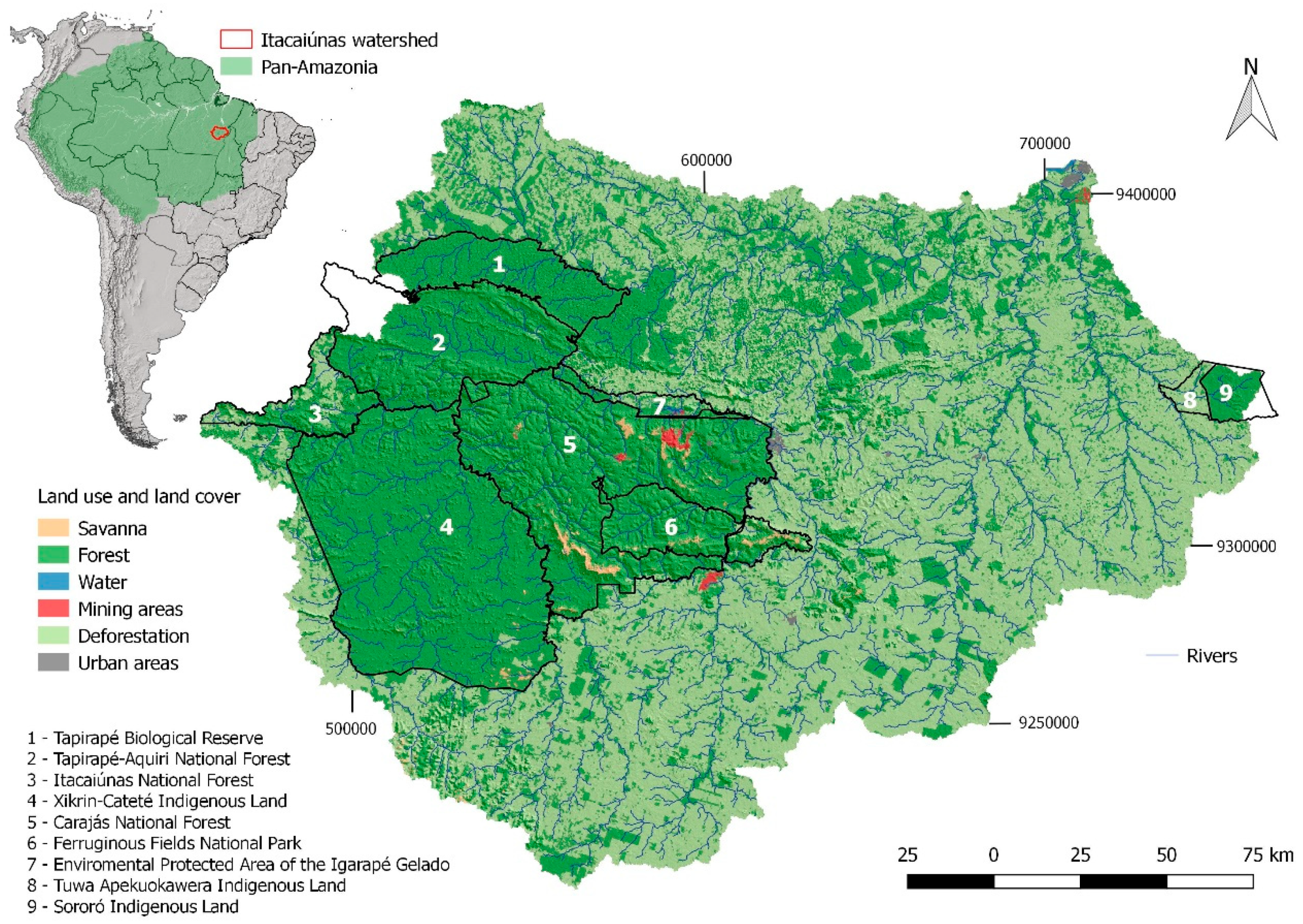
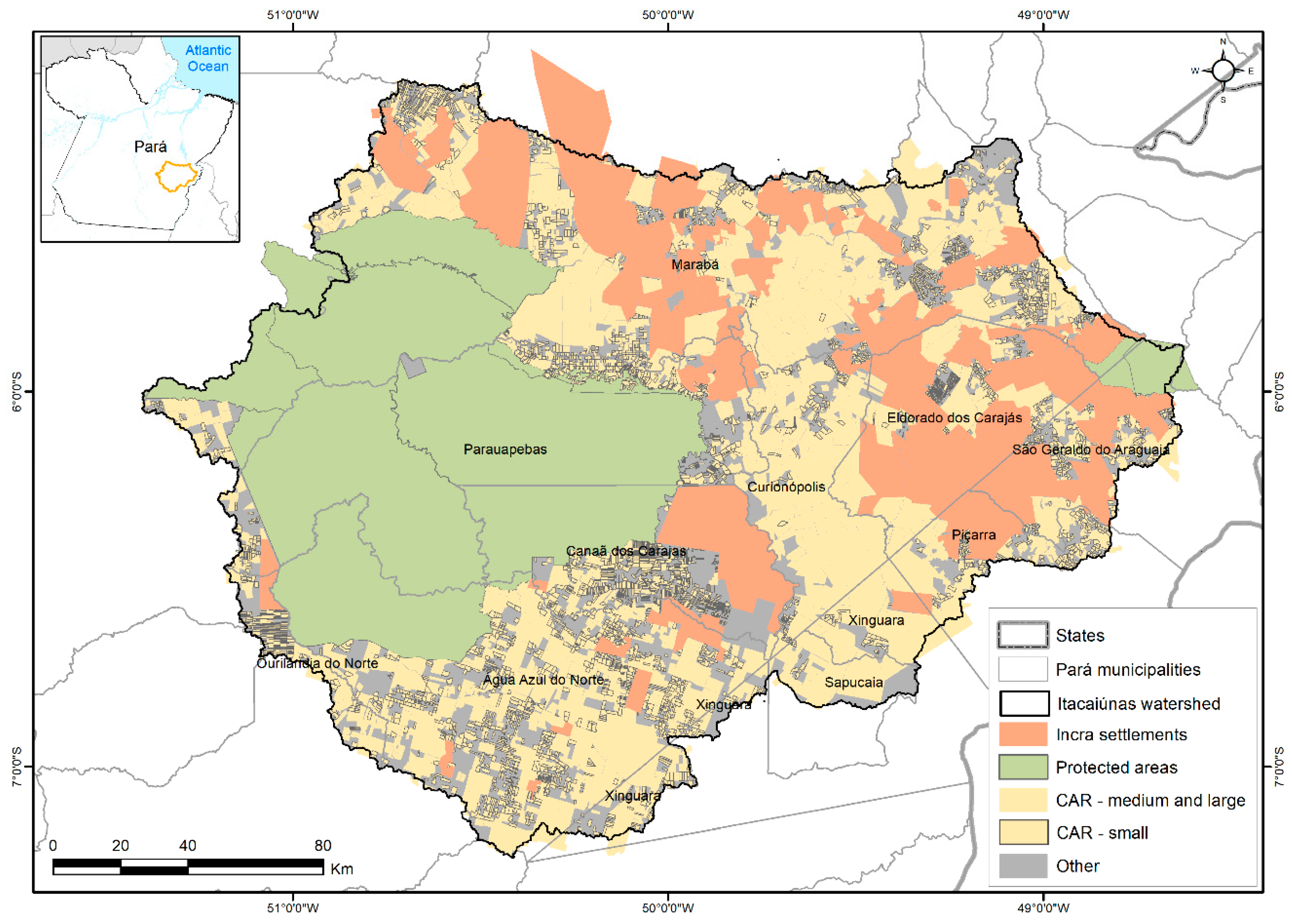
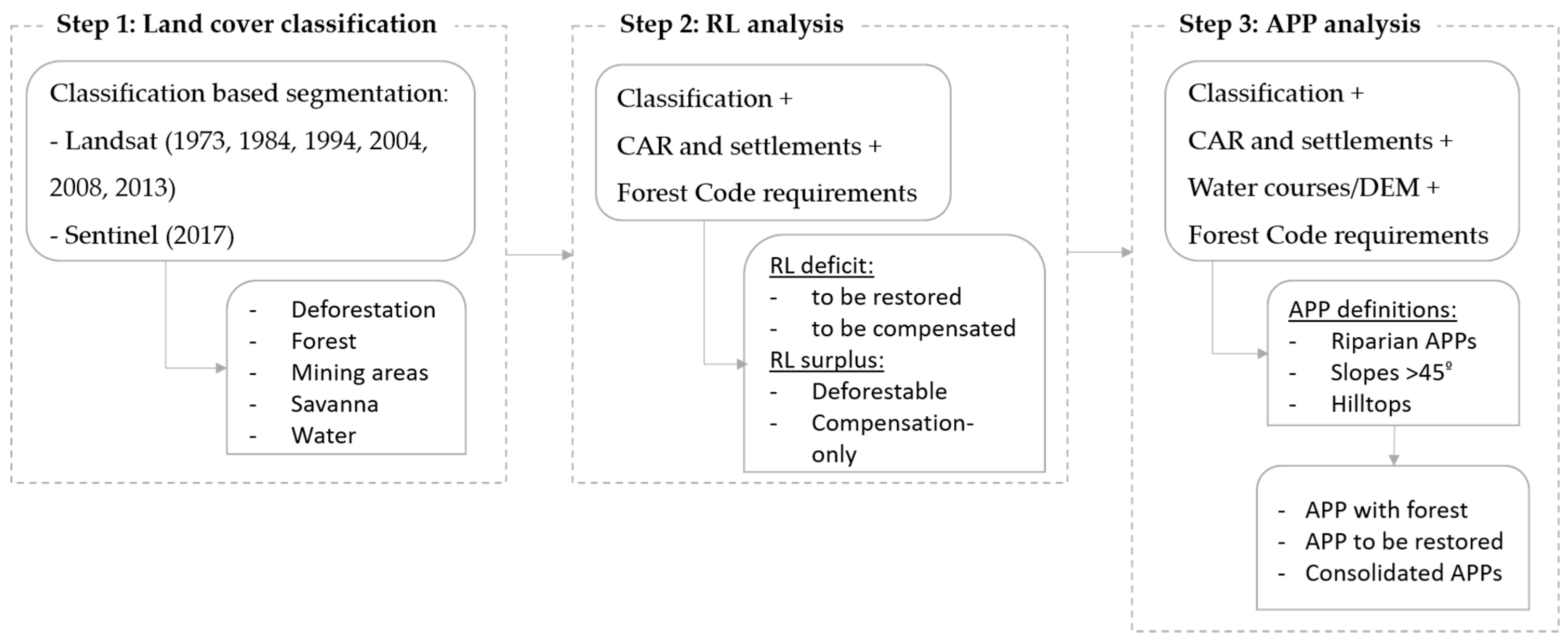
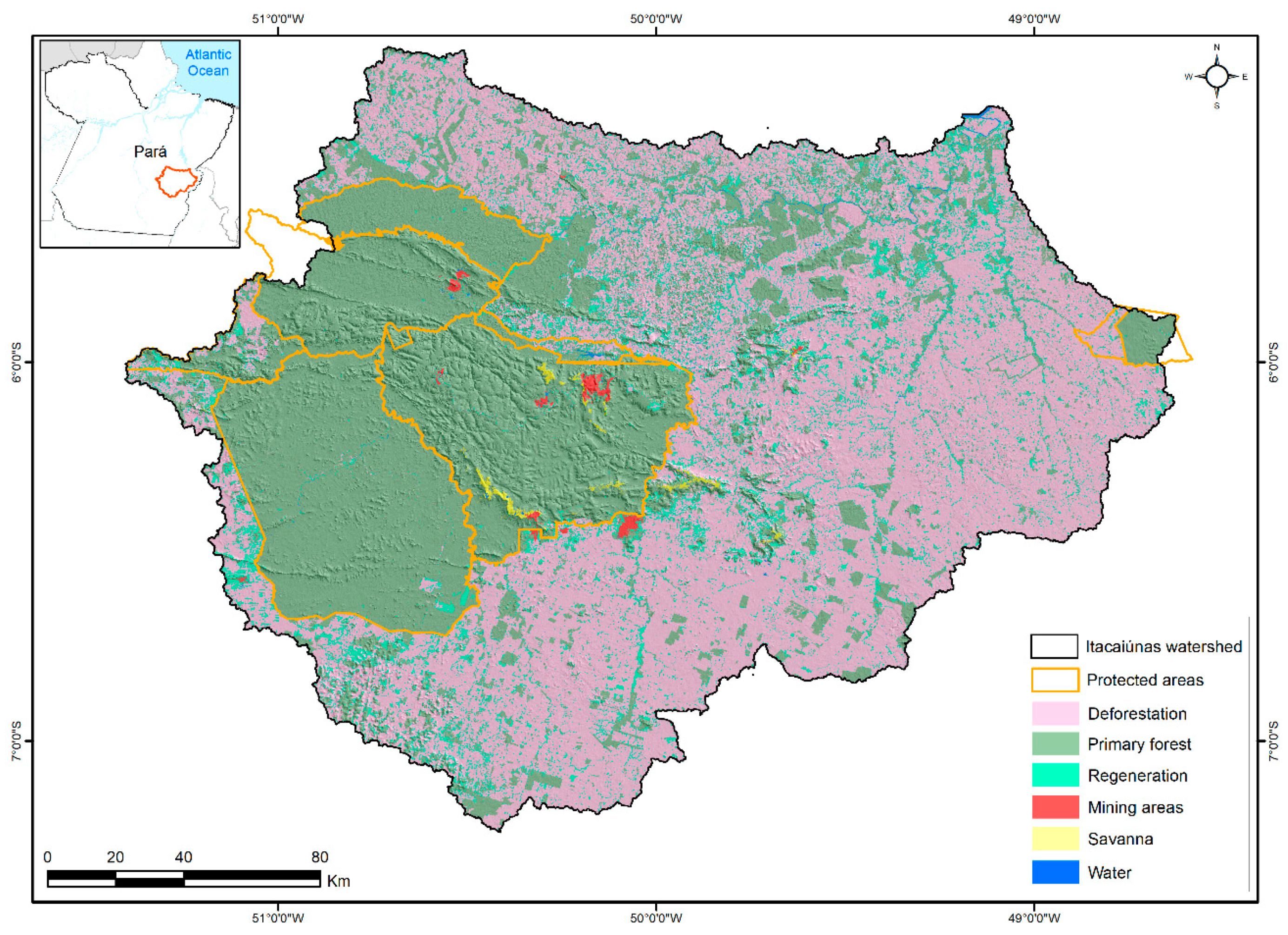
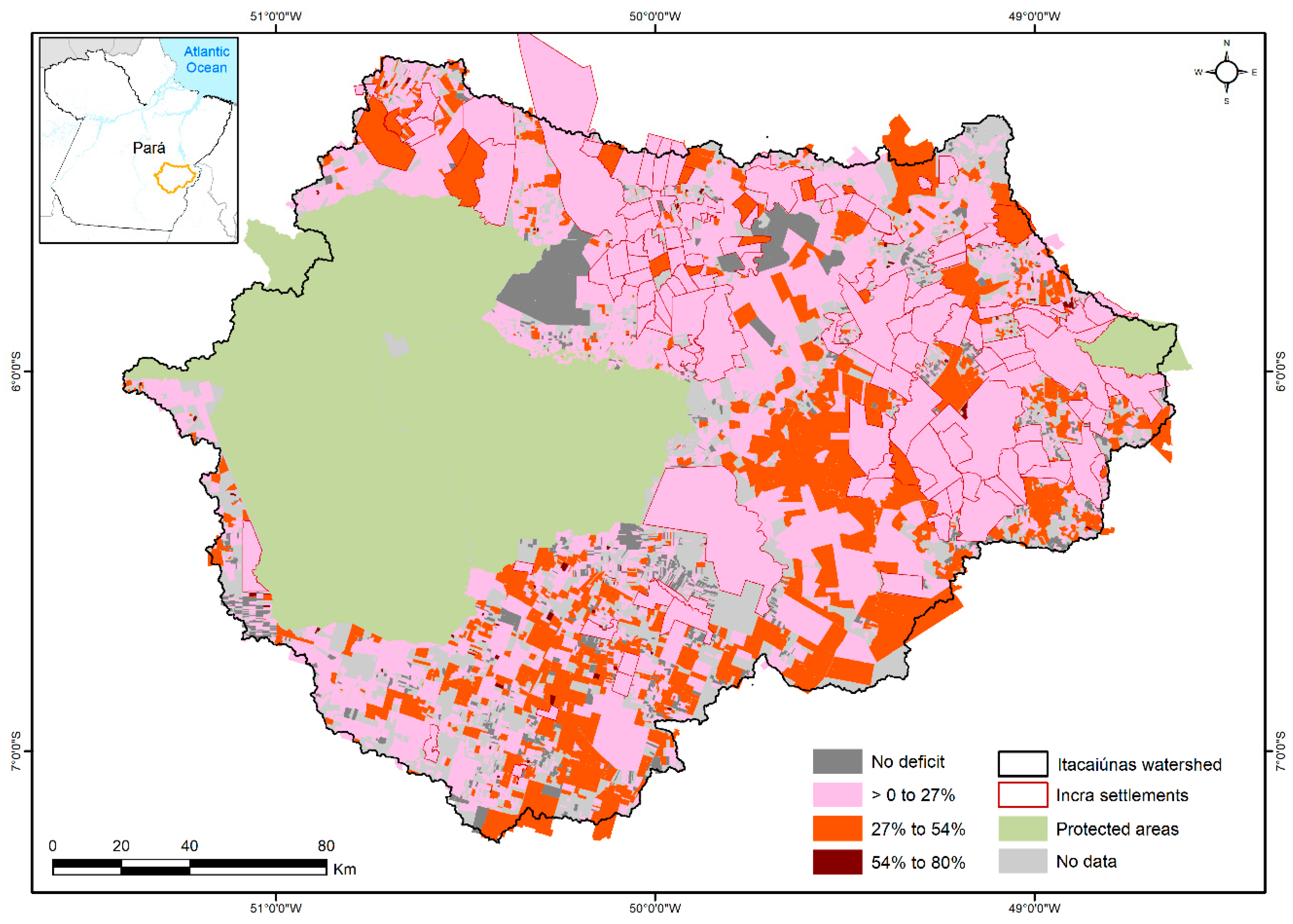
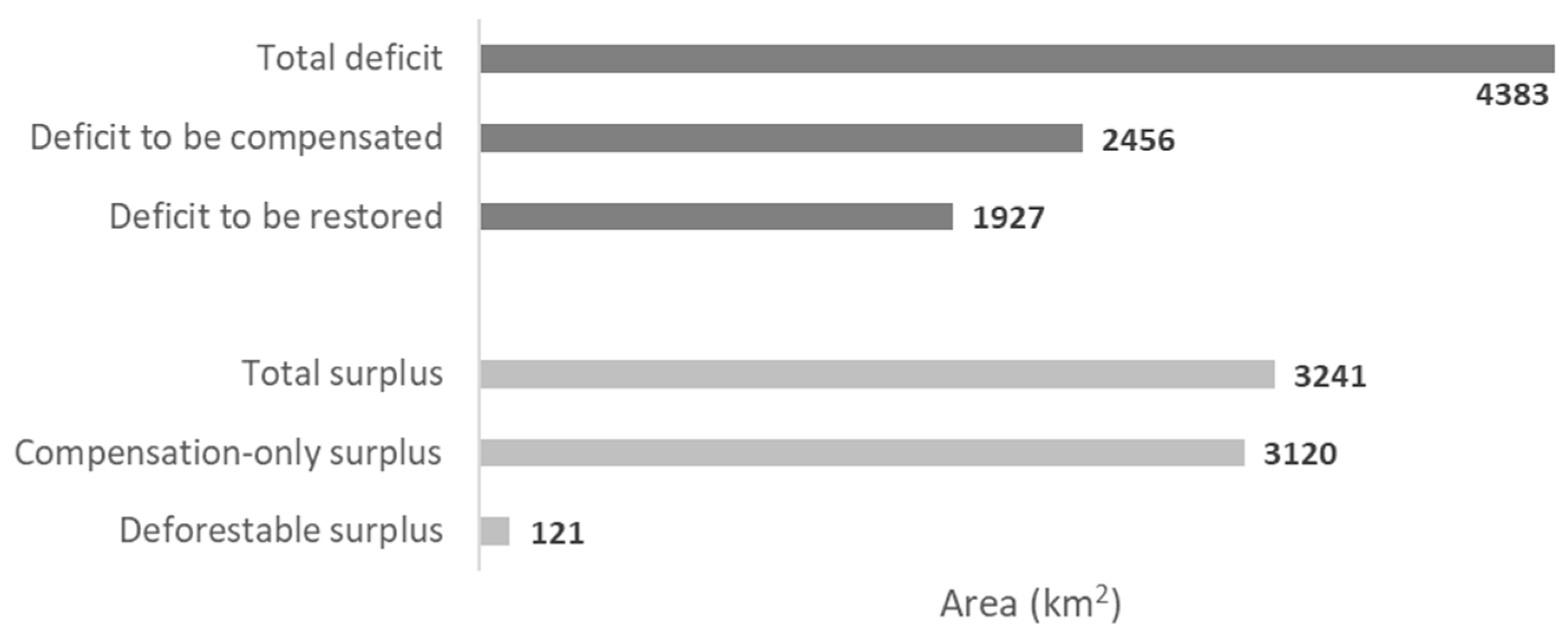
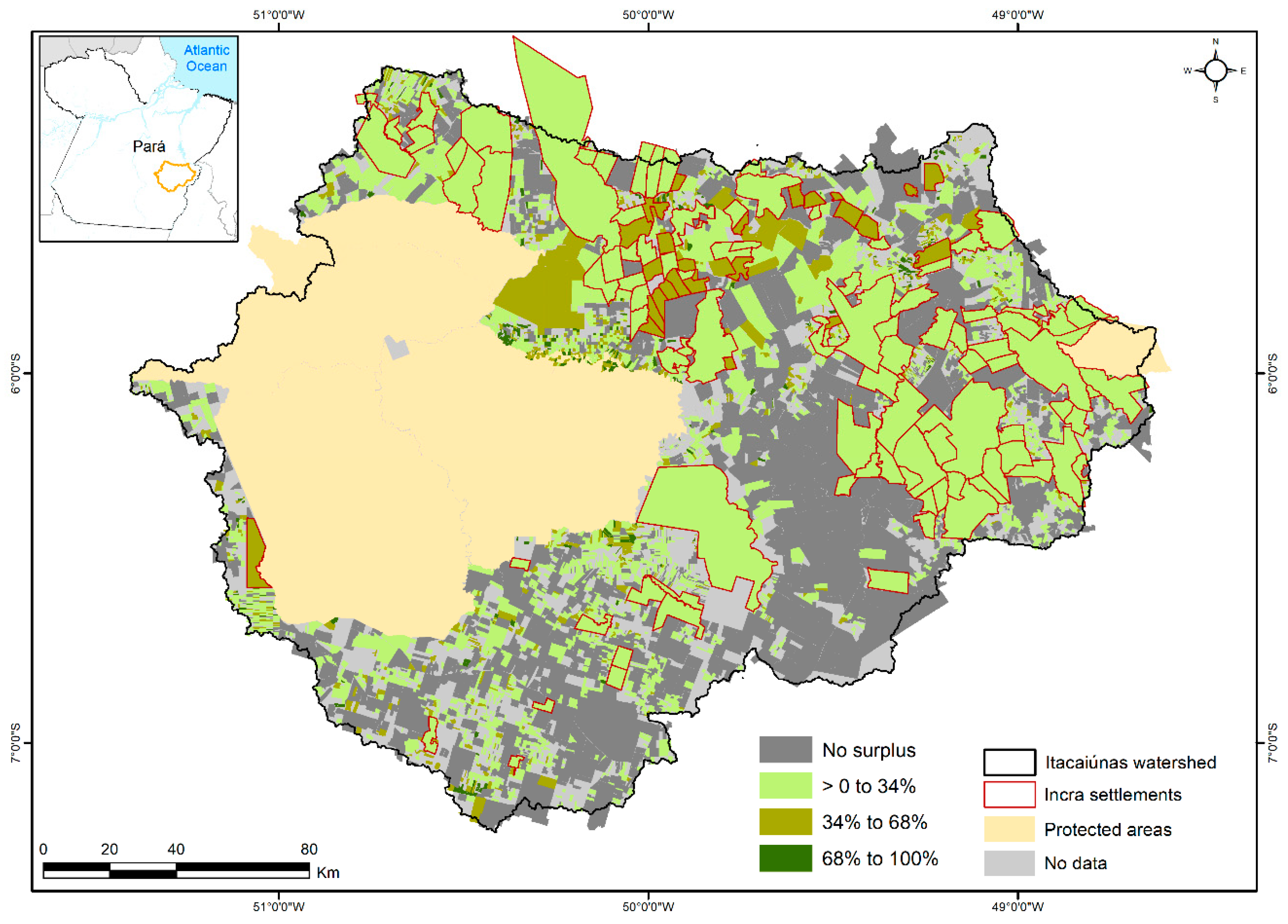
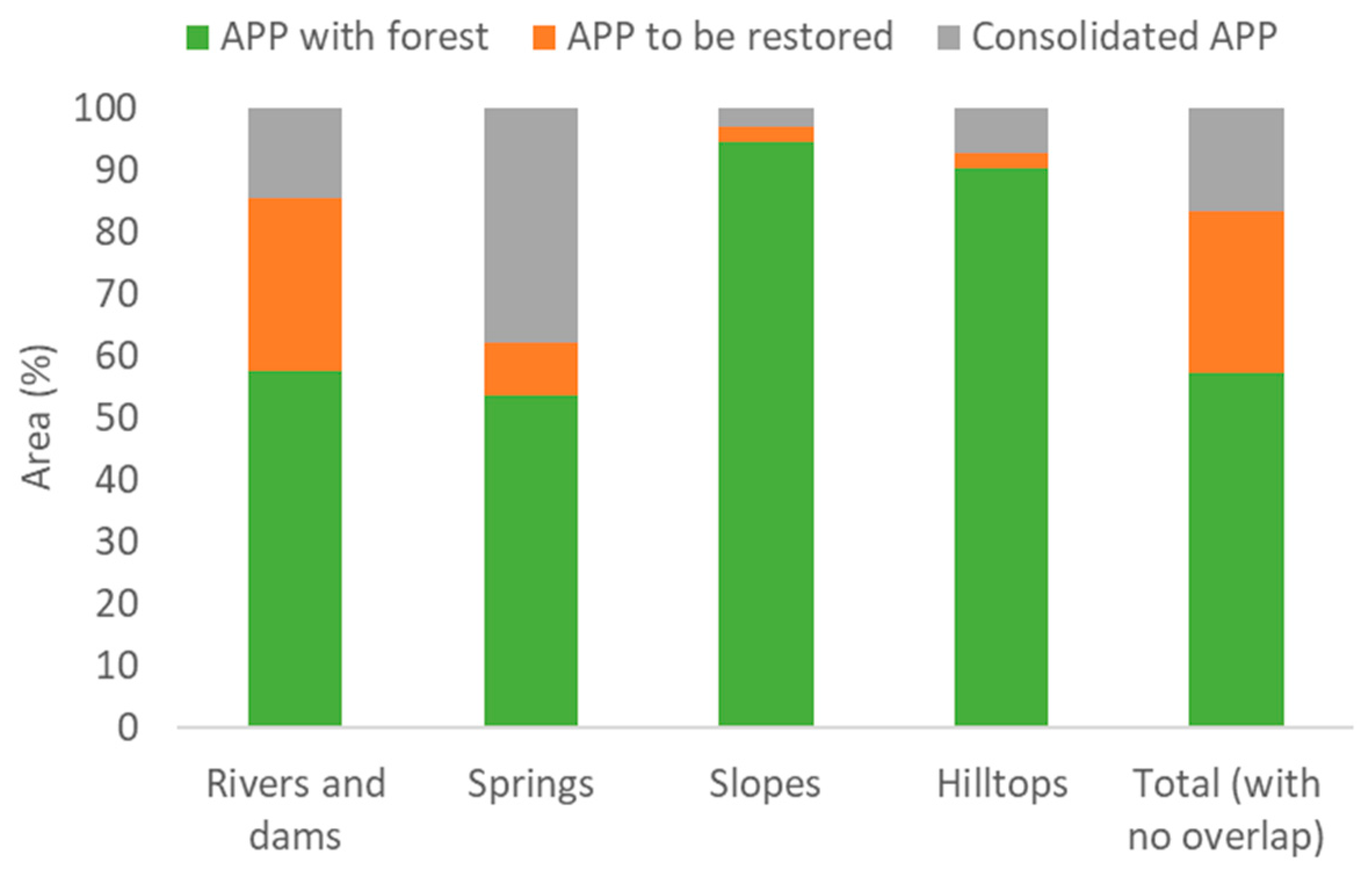

| Dataset | Source | Year | Scale/Resolution | Reference Image |
|---|---|---|---|---|
| Settlements | Incra | 2013 | - | - |
| Protected areas | ICMBio | 2015 | - | - |
| CAR | SEMAS-Pará | 2017 | - | - |
| Land cover classification | ITV | 1973, 1984, 1994, 2004, 2008, 2013 | 1:150.000 (30 m) | Landsat-5/8 |
| Land cover classification | ITV | 2017 | 1:50.000 (10 m) | Sentinel-2A |
| Rivers | ITV | 2011 | 1:50.000 (12.5 m) | ALOS PALSAR |
| DEM | ITV | 2011 | 1:50.000 (12.5 m) | ALOS PALSAR |
| Water Course | Width/Area of Water Body | APP Width |
|---|---|---|
| Rivers | <10 m | 30 m |
| 10–50 m | 50 m | |
| 50–200 m | 100 m | |
| 200–600 m | 200 m | |
| >600 m | 500 m | |
| Lakes and dams | <1 ha | - |
| >1 ha | 15 m | |
| Springs | - | 30 m |
| Water Course | Width/Area of Water Body | Property Size | APP to Be Restored |
|---|---|---|---|
| Rivers | all | small (≤1 FM) | 5 m |
| all | small (>1 FM and ≤2 FM) | 8 m | |
| all | small (>2 FM and ≤4 FM) | 15 m | |
| ≤10 m | medium (>4 FM and ≤10 FM) | 20 m | |
| >10 m | medium (>4 FM and ≤10 FM) | *30–100 m | |
| all | medium/large (>10 FM) | *30–100 m | |
| Lakes and dams | >1 ha | all | 15 m |
| Springs | - | all | 15 m |
| APP Type | Total APP | APPs with Forest | APPs to Be Restored | Consolidated APPs |
|---|---|---|---|---|
| (km2) | (km2) | (km2) | (km2) | |
| Rivers and reservoirs | 4867.6 | 2808.0 | 1348.3 | 711.3 |
| Springs | 793.2 | 426.8 | 66.5 | 300.0 |
| Slopes > 45° | 14.8 | 14.0 | 0.4 | 0.4 |
| Hilltops | 15.0 | 13.6 | 0.4 | 1.1 |
| Total (with no overlap) | 5254.8 | 3017.3 | 1356.3 | 881.2 |
© 2019 by the authors. Licensee MDPI, Basel, Switzerland. This article is an open access article distributed under the terms and conditions of the Creative Commons Attribution (CC BY) license (http://creativecommons.org/licenses/by/4.0/).
Share and Cite
Nunes, S.; Cavalcante, R.B.L.; Nascimento, W.R., Jr.; Souza-Filho, P.W.M.; Santos, D. Potential for Forest Restoration and Deficit Compensation in Itacaiúnas Watershed, Southeastern Brazilian Amazon. Forests 2019, 10, 439. https://doi.org/10.3390/f10050439
Nunes S, Cavalcante RBL, Nascimento WR Jr., Souza-Filho PWM, Santos D. Potential for Forest Restoration and Deficit Compensation in Itacaiúnas Watershed, Southeastern Brazilian Amazon. Forests. 2019; 10(5):439. https://doi.org/10.3390/f10050439
Chicago/Turabian StyleNunes, Sâmia, Rosane B. L. Cavalcante, Wilson R. Nascimento, Jr., Pedro Walfir M. Souza-Filho, and Diogo Santos. 2019. "Potential for Forest Restoration and Deficit Compensation in Itacaiúnas Watershed, Southeastern Brazilian Amazon" Forests 10, no. 5: 439. https://doi.org/10.3390/f10050439
APA StyleNunes, S., Cavalcante, R. B. L., Nascimento, W. R., Jr., Souza-Filho, P. W. M., & Santos, D. (2019). Potential for Forest Restoration and Deficit Compensation in Itacaiúnas Watershed, Southeastern Brazilian Amazon. Forests, 10(5), 439. https://doi.org/10.3390/f10050439





